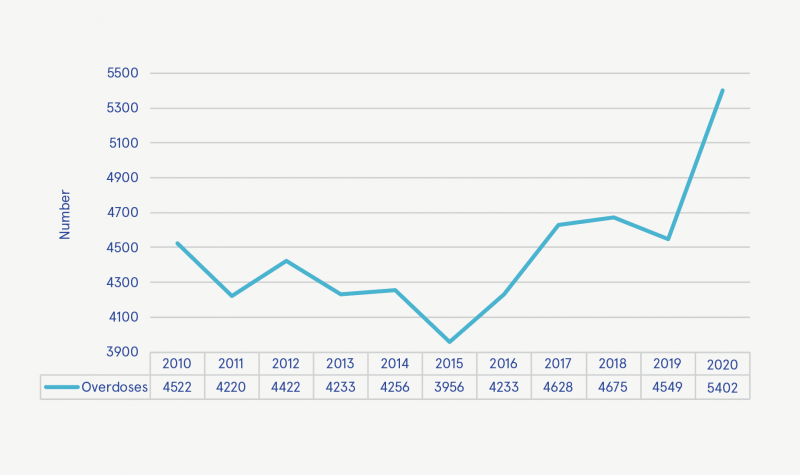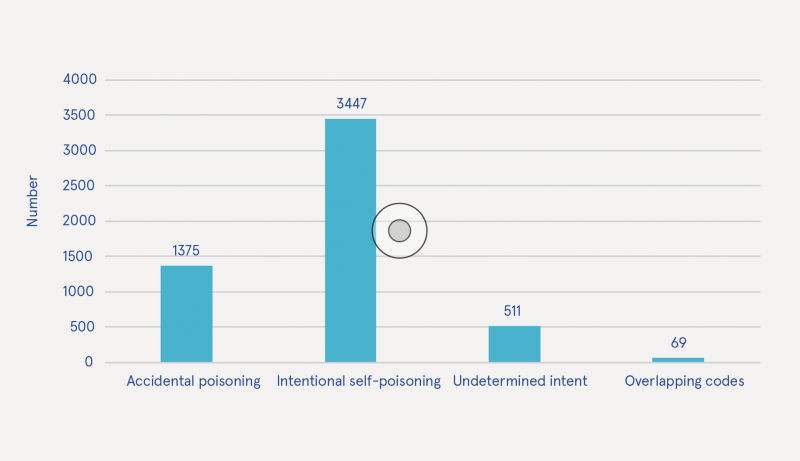Millar, Sean (2022) Not-fatal drug-related hospital admissions in Ireland, 2020. Drugnet Ireland, Issue 83, Winter 2022, pp. 16-20.
| Preview | Title | Contact |
|---|---|---|
|
PDF (Drugnet Ireland 83)
741kB |
The HIPE (Hospital In-Patient Enquiry) scheme is a computer-based health information system, managed by the Economic and Social Research Institute (ESRI) in association with the Department of Health and the Health Service Executive. It collects demographic, medical, and administrative data on all admissions, discharges, and deaths from acute general hospitals in Ireland. Each HIPE discharge record represents one episode of care; each discharge of a patient, whether from the same or a different hospital, with the same or a different diagnosis, gives rise to a separate HIPE record. The scheme therefore facilitates analysis of hospital activity rather than of the incidence of disease. HIPE does not record information on individuals who attend emergency departments but are not admitted as inpatients. Monitoring of drug-related acute emergencies in the Irish context refers to all admissions for non-fatal overdoses to acute general hospitals in Ireland.
Drug-related emergencies – non-fatal overdoses
Data extracted from the HIPE scheme were analysed to determine trends in non-fatal overdoses in patients discharged from Irish hospitals in 2020.1 There were 5,457 overdose cases in that year, of which 55 died in hospital. Only discharged cases are included in this analysis (n=5402). The number of discharged overdose cases in 2020 was the highest recorded in 10 years, with trends indicating a general increase since 2015 (see Figure 1).
Sex of overdose cases
Between 2010 and 2020, there were more overdose cases among women than men, with women accounting for 3,092 (57.2%) of all non-fatal overdose cases in 2020 (see Figure 2).
Age group
Between 2015 and 2020, there has been a general increase in the number of non-fatal overdose cases in all age groups. As noted in previous years, the incidence of overdose cases peaked in the 15–24-age group (see Figure 3). In 2020, some 34.7% of cases were under 25 years of age.

Source: HIPE, Healthcare Pricing Office (2022)
Figure 1: Number of non-fatal overdose cases admitted to Irish hospitals, by year, 2010–2020

Source: HIPE, Healthcare Pricing Office (2022)
Figure 2: Number of non-fatal overdose cases admitted to Irish hospitals, by year and sex, 2010–2020

Source: HIPE, Healthcare Pricing Office (2022)
Figure 3: Non-fatal overdose cases admitted to Irish hospitals, by year and age group, 2010–2020

Source: HIPE, Healthcare Pricing Office (2022)
Figure 4: Narcotics and hallucinogens involved in non-fatal overdose cases admitted to Irish hospitals, 2020

Source: HIPE, Healthcare Pricing Office (2022)
Figure 5: Non-fatal overdose cases admitted to Irish hospitals, classified by intent, 2020
Table 1: Categories of drugs involved in non-fatal overdose cases admitted to Irish hospitals, 2020

Source: HIPE, Healthcare Pricing Office (2022)
Note: The sum of positive findings is greater than the total number of cases, as some cases involved more than one drug or substance.
* Alcohol was only included for cases where any code from any of the other drug categories in this table was also reported.
Toxicology of drug-related acute emergencies
Table 1 presents the positive findings per category of drugs and other substances involved in all cases of overdose in 2020. Non-opioid analgesics were present in 1,880 of cases. Paracetamol is included in this drug category and was present in 1,580 of cases. Benzodiazepines and psychotropic agents were taken in 1,111 and 1,416 of cases, respectively. There was evidence of alcohol consumption in 519 of cases. Cases involving alcohol are included in this analysis only when alcohol was used in conjunction with another substance.
Overdoses involving narcotics or hallucinogens
Figure 4 shows positive findings of illicit substances among overdose cases in 2020. Opioids were used in 16.6% (n=897) of cases, cocaine in 5.8% (n=313), and cannabis in 1.8% (n=98) of cases. There were 14 overdose cases involving LSD.
Table 2: Categories of drugs involved in intentional self-poisoning cases admitted to Irish hospitals, 2020

Source: HIPE, Healthcare Pricing Office (2022)
Note: As some discharges may be included in more than one drug category, the total count in this table exceeds the total number of discharges.
* Alcohol was only included for cases where any code from any of the other drug categories in this table was also reported.
Overdoses classified by intent
In 2020, for 63.8% (n=3447) of cases, the overdose was classified as intentional (see Figure 5). For 9.4% (n=511) of cases, classification of intent was not clear.
Table 2 presents the positive findings per category of drugs and other substances involved in cases of intentional self-poisoning (n=3447) in 2020. Non-opioid analgesics were involved in 1,590 of cases, benzodiazepines in 744, and psychotropic agents in 1,101 of cases.
1 For further information on HIPE data, visit the Healthcare Pricing Office website: http://www.hpo.ie/
B Substances > Hallucinogens / Psychedelics
B Substances > Cocaine
B Substances > Opioids (opiates)
E Concepts in biomedical areas > Medical substance > Over the counter drug (medicine / medication)
E Concepts in biomedical areas > Medical substance > Prescription drug (medicine / medication)
F Concepts in psychology > Behaviour > Self-destructive behaviour / self-harm > Suicidal behaviour / suicide
G Health and disease > Substance use disorder (addiction) > Drug use disorder > Drug intoxication > Poisoning (overdose)
J Health care, prevention, harm reduction and treatment > Type of care > Emergency care
J Health care, prevention, harm reduction and treatment > Health care programme, service or facility > Hospital
VA Geographic area > Europe > Ireland
Repository Staff Only: item control page